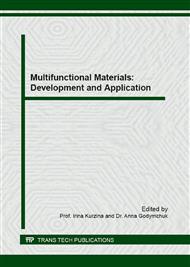[1]
C.A. Edwards, I. Burrows, K.E. Fletcher, B.A. Jones, The use of earthworms for composting farm wastes, in J.K.R. Gasser (Eds. ), Composting Agricultural and Other Wastes, Elsevier, London and New York, 1985, pp, 229-241.
Google Scholar
[2]
R. Hartenstein, M.S. Bisesi, Use of earthworm biotechnology for the management of effluents from intensively housed livestock, Outlook on Agriculture 18 (1989) 3-7.
DOI: 10.1177/003072708901800205
Google Scholar
[3]
N. Arancon, C. Edwards, A. Babenko, J. Cannon, P. Galvis, J. Metzger Influences of vermicompost produced by earthworms and micro-organisms from cattle manure, food waste and paper waste, on the germination, growth and flowering of petunias in the greenhouse, Applied Soil Ecology 39 (2008).
DOI: 10.1016/j.apsoil.2007.11.010
Google Scholar
[4]
R.M. Atiyeh, S. Subler, C.A. Edwards, G. Bachman, J.D. Metzger, W. Shuster, Effects of vermicomposts and composts on plant growth in horticultural container media and soil, Pedobiologia 44 (2000) 579-590.
DOI: 10.1078/s0031-4056(04)70073-6
Google Scholar
[5]
N.N. Tereshchenko, A.V. Kravets, E.E. Akimova, O.M. Minayeva, A.P. Zotikova Effectiveness of applying microorganisms isolated from earthworm coprolites in increasing yielding capacity of grain crops, Sib. Her. Agricul. Sci 5 (2013) 10-17.
Google Scholar
[6]
P.L.S. Chan, D.A. Griffiths, The vermicomposting of pre-treated pig manure, Biological Wastes 24 (1988) 57-69.
DOI: 10.1016/0269-7483(88)90027-4
Google Scholar
[7]
R.M. Atiyeh, C.A. Edwards, S. Subler, J.D. Metzger, Pig manure vermicompost as a component of a horticultural bedding plant medium: effects on physicochemical properties and plant growth, Bioresource Technology 78 (2001) 11-20.
DOI: 10.1016/s0960-8524(00)00172-3
Google Scholar
[8]
T.C. Hsiao, A. Lauchli, Role of potassium in plant-water relations, in B. Tinker, A. Lauchli (Eds. ), Adv. Plant Nutr., Praeger Sci., New York, 1986, pp.281-312.
Google Scholar
[9]
R.A. Bressan, P.M. Hasegawa, J.M. Pardo, Plants use calcium to resolve salt stress, Trends in Plant Science, 3 (1998) 411-412.
DOI: 10.1016/s1360-1385(98)01331-4
Google Scholar
[10]
B.W. Poovaiah, A.S.N. Reddy, Calcium and Signal Transduction in Plants, Critical Reviews in Plant Sciences 12 (1993) 185-185.
DOI: 10.1080/07352689309701901
Google Scholar
[11]
T. Sariyildiz, J.M. Anderson, Variation in the chemical composition of green leaves and leaf litters from three deciduous tree species growing on different soil types, Forest Ecol. Manag 210 (2005) 303-319.
DOI: 10.1016/j.foreco.2005.02.043
Google Scholar
[12]
B. Lemma, I. Nilsson, D.B. Kleja, M. Olsson, H. Knicker, Decomposition and substrate quality of leaf litters and fine roots from three exotic plantations and a native forest in the southwestern highlands of Ethiopia, Soil Bio. Biochem 39 (2007).
DOI: 10.1016/j.soilbio.2007.03.032
Google Scholar
[13]
M. Carnol, M. Bazgir, Nutrient return to the forest floor through litter and throughfall under 7 forest species after conversion from Norway spruce, Forest Ecol. Manag 12 (2013) 66-75.
DOI: 10.1016/j.foreco.2013.04.008
Google Scholar
[14]
Y. Ma, T.R. Filley, K. Szlavecz, M.K. McCormick, Controls on wood and leaf litter incorporation into soil fractions in forests at different successional stages, Soil Bio. Biochem 69 (2014) 212-222.
DOI: 10.1016/j.soilbio.2013.10.043
Google Scholar
[15]
L. Cizungu, J. Staelens, D. Huygens, J. Walangululu, D. Muhindo, O.V. Cleemput, P. Boeckx, Litterfall and leaf litter decomposition in a central African tropical mountain forest and Eucalyptus plantation, Forest Ecol. Manag 326 (2014) 109-116.
DOI: 10.1016/j.foreco.2014.04.015
Google Scholar
[16]
T. Li, Y. Ye, Dynamics of decomposition and nutrient release of leaf litter in Kandelia obovata mangrove forests with different ages in Jiulongjiang Estuary, China, Ecological Engineering 73 (2014) 454-460.
DOI: 10.1016/j.ecoleng.2014.09.102
Google Scholar
[17]
A. Cuchiettia, E. Marcotti, D.E. Gurvich, A.M. Cingolani, N. PérezHarguindeguy, Leaf litter mixtures and neighbor effects: Low-nitrogen and high-lignin species increase decomposition rate of high-nitrogen and low-lignin neighbours, Appl. Soil Ecol 82 (2014).
DOI: 10.1016/j.apsoil.2014.05.004
Google Scholar
[18]
N.G. Osmolovskaya, L.N. Kuchaeva, V.A. Novak Role of organic acids in the formation of the ionic composition in developing glycophyte leaves, Rus. J Plant Phys 54 (2007) 336-342.
DOI: 10.1134/s1021443707030077
Google Scholar
[19]
K. Petrochenko, A. Kurovskiy, A. Babenko, Ionic homeostasis and some other features of Eisenia fetida (Oligochaeta) cultivated on substrates of various characters and of different chemical composition, Advances in Earthworm Taxonomy VI (Annelida: Oligochaeta), Heidelberg, Kasparek Verlag (2014).
Google Scholar
[20]
W. Larcher, Plant Ecology, Verlag Eugen Ulmer, Stuttgart, (1978).
Google Scholar
[21]
A.V. Kurovskiy, Ecological-physiological aspects of calcium requirement of herbs, Tomsk State Univ. J. 329 (2009) 237-240.
Google Scholar
[22]
J.W. Schiefelbein, A. Shipley, P. Rowse, Calcium influx at the tip of growing root-hair cells of Arabidopsis thaliana, Planta 187 (1992) 455-459.
DOI: 10.1007/bf00199963
Google Scholar
[23]
J.F. Ponge, N. Patzel, L. Delhaye, E. Devigne, C. Levieux, P. Beros, R. Wittebroodt, Interactions between earthworms, litter and trees in an old-growth beech forest, Bio. Fert. Soils 29 (1999) 360-370.
DOI: 10.1007/s003740050566
Google Scholar
[24]
P.B. Reich, J. Oleksyn, J. Modrzynski, P. Mrozinski, S.E. Hobbie, D.M. Eissenstat, J. Cho-Rover, O.A. Chadwick, C. Hale, M.G. Tjoelker, Linking litter calcium, earth-worms and soil properties: a common garden test with 14 tree species, Ecology 8 (2005).
DOI: 10.1111/j.1461-0248.2005.00779.x
Google Scholar
[25]
M.G. Canti, T.G. Piearce, Morphology and dynamics of calcium carbonate granules produced by different earthworm species, Pedobiologia 47 (2002) 511-521.
DOI: 10.1078/0031-4056-00221
Google Scholar


